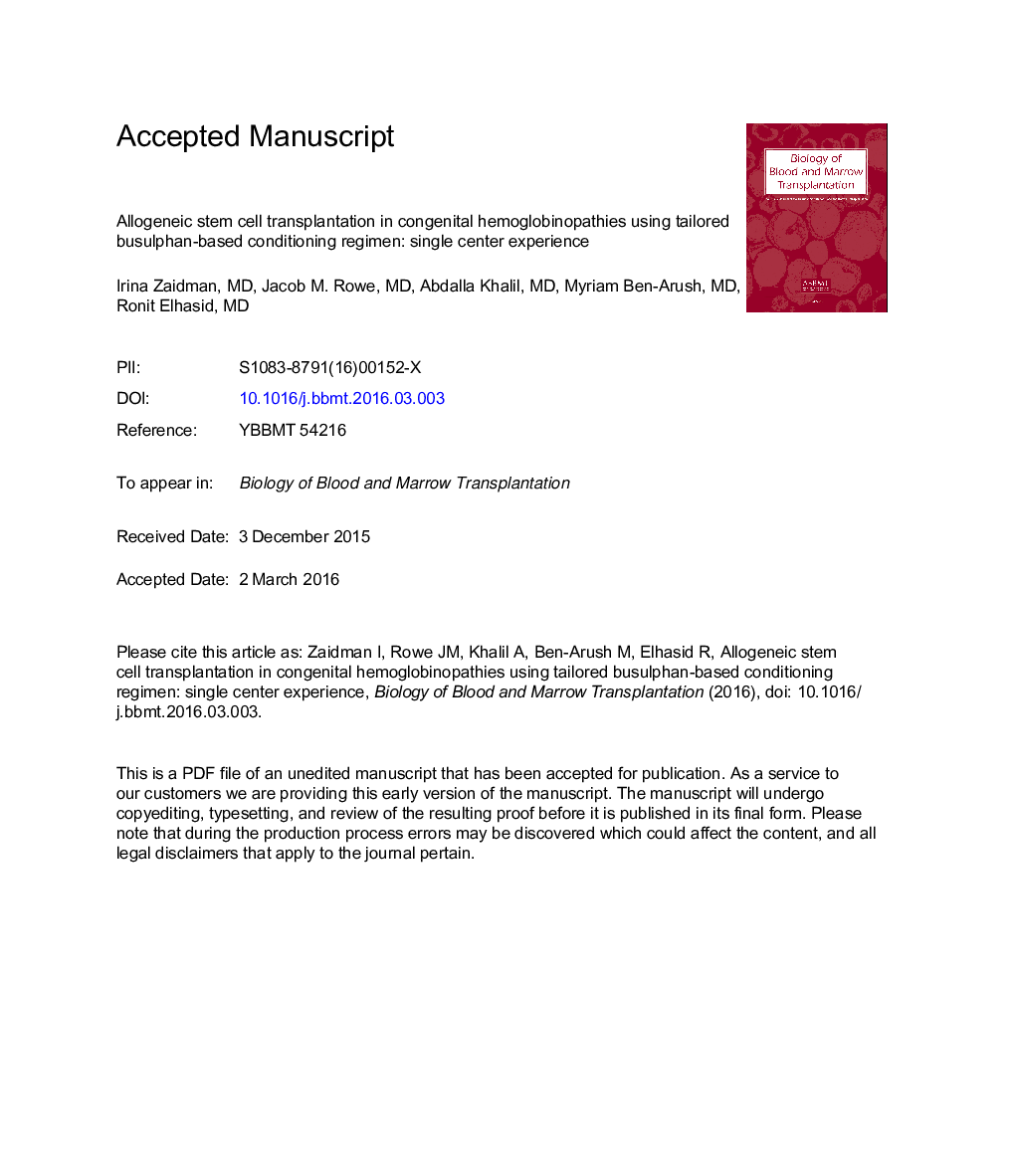| کد مقاله | کد نشریه | سال انتشار | مقاله انگلیسی | نسخه تمام متن |
|---|---|---|---|---|
| 8431083 | 1546253 | 2016 | 30 صفحه PDF | دانلود رایگان |
عنوان انگلیسی مقاله ISI
Allogeneic Stem Cell Transplantation in Congenital Hemoglobinopathies Using a Tailored Busulfan-Based Conditioning Regimen: Single-Center Experience
ترجمه فارسی عنوان
پیوند سلولهای آلوژنیک در هموگلوبینوپاتی های مادرزادی با استفاده از یک رژیم تهویه مطبوع مبتنی بر بوپولان: تجربه یک مرکز
دانلود مقاله + سفارش ترجمه
دانلود مقاله ISI انگلیسی
رایگان برای ایرانیان
کلمات کلیدی
موضوعات مرتبط
علوم زیستی و بیوفناوری
بیوشیمی، ژنتیک و زیست شناسی مولکولی
تحقیقات سرطان
چکیده انگلیسی
Hematopoietic stem cell transplantation (HSCT) is the only proven curative option for patients with hemoglobinopathies, both thalassemia and sickle cell anemia (SCA). A busulfan-based myeloablative conditioning regimen is the standard of care for HSCT in these patients, although increased treatment-related morbidity, including veno-occlusive disease (VOD), has been demonstrated. Thirty-eight pediatric patients, median age 8 years (range, 6 months to 22 years), suffering from hemoglobinopathy were treated at Rambam Medical Center in Haifa, Israel, between 1998 and 2011. Thirty-four patients had thalassemia major and 4 had SCA. The 38 patients underwent 40 HSCTs, 34 of which were first transplants and 6 second transplants. Most transplants (32/40) were from matched sibling donors. Sources of stem cells were peripheral blood in 30 transplants, bone marrow in 7 transplants, and cord blood in 3 transplants. All received different customized busulfan-based conditioning regimens tailored by pharmacokinetic analysis of busulfan levels. Primary engraftment occurred in 37 of 40 transplants. Neutrophil engraftment (>.5 Ã 109/L) occurred at a median of 15.3 days post-transplantation (range, 10 to 45). Platelet transfusion independence (>20 Ã 109/L) occurred at a median of 22.3 days (range, 11 to 60). The rate of 5-year overall survival for thalassemia patients after first transplantation was 90.5% ± 5.3%. The rate of 5-year thalassemia-free survival was 81.7% ± 6.8%. Cumulative incidence of acute graft-versus-host disease (GVHD) was 17.6%. Rate of grades III to IV GVHD was 8.8%. Cumulative incidence of chronic GVHD was 23.5%, with 11.8% incidence of extensive chronic GVHD. One patient developed VOD. Full donor chimerism occurred in 36.4% of patients with class 1 + 2 thalassemia, compared with 78.6% in class 3 thalassemia (P = .049). Overall survival above 90% in patients undergoing their first transplant was demonstrated using busulfan-based conditioning regimens. The low incidence of VOD was probably due to busulfan area under the curve measurements and dose adjustment.
ناشر
Database: Elsevier - ScienceDirect (ساینس دایرکت)
Journal: Biology of Blood and Marrow Transplantation - Volume 22, Issue 6, June 2016, Pages 1043-1048
Journal: Biology of Blood and Marrow Transplantation - Volume 22, Issue 6, June 2016, Pages 1043-1048
نویسندگان
Irina Zaidman, Jacob M. Rowe, Abdalla Khalil, Myriam Ben-Arush, Ronit Elhasid,
